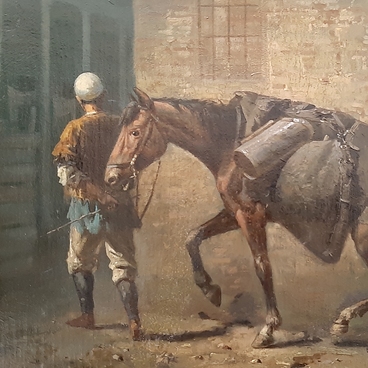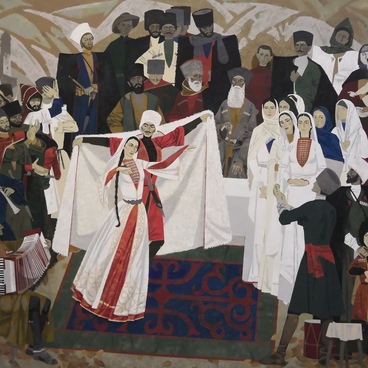Pyotr Zakharov-Chechenets painted his Self-Portrait in a Felt Cloak with a Gun in 1843. Actually, recent research has not confirmed the painting is a self-portrait. So who the model was is yet to be discovered.
Before the 1917 revolution, the picture was referred to by various documents as Portrait of a Mountaineer or Portrait of a Circassian. Later, Soviet art explorers came to think that the painter portrayed himself as a mountaineer. Present-time scholars tend to believe that the assumption as erroneous: Zakharov-Chechenets dies when he was only 30 while the portrait depicts a mature man. The research is still on, so the picture is so far exhibited with its traditional Soviet name, Self-Portrait in a Felt Cloak with a Gun.
The picture represents a man wearing a felt cloak and a mountain hat, with a gun on his shoulder. The artist employed a reserved, almost single-colour gamut. The ochroid-green background grades into black clothing. This artistic solution helps the character’s light face stand out particularly brightly. The viewer’s attention is specifically attracted by the man’s eyes: his look suggests sadness and wisdom of a person who has lived and seen a lot.
The exotic costume imparts romantic features to the portrait, while the artistic treatment of the man himself is realistic. Critics have noted that the picture captures attention by “its severe truth, not exotic features”. The Self-Portrait in a Felt Cloak with a Gun is thought to be the first portrait of a mountaineer by a mountaineer in the 19th century.
Pyotr Zakharov was the only professional painter of Chechen origin in the 19th century. According to hearsay, his story inspired the poet Mikhail Lermontov to write Mtsyri. During the Caucasian war, Zakharov lost his parents: the three-year-old boy was picked up by soldiers after a fight near the village of Dadi-Yurt in 1819. He was baptised Pyotr and got his patronymic and last name from Zakhar Nedonosov, the soldier who took care of him. Later, Pyotr was taken into the care of Pyotr Yermolov, the cousin of General Alexei Yermolov.
Pyotr Yermolov noticed the adopted boy’s artistic talent. He took a lot of effort to make sure the non-Russian child was accepted as an ‘outsider student’ of the Academy of Arts in St. Petersburg. Pyotr Zakharov-Chechenets soon won recognition. He was particularly fond of portraiture. The artist never forgot his origins and signed his works as ‘Zakharov-Chechenets’ (i.e. Zakharov the Chechen), ‘Zakharov of Dada-Yurt’, ‘Zakharov, a Chechen’, ‘Chechen of Dada-Yurt’. He only lived 30 years and died at the end of summer 1846 of tuberculosis.
Before the 1917 revolution, the picture was referred to by various documents as Portrait of a Mountaineer or Portrait of a Circassian. Later, Soviet art explorers came to think that the painter portrayed himself as a mountaineer. Present-time scholars tend to believe that the assumption as erroneous: Zakharov-Chechenets dies when he was only 30 while the portrait depicts a mature man. The research is still on, so the picture is so far exhibited with its traditional Soviet name, Self-Portrait in a Felt Cloak with a Gun.
The picture represents a man wearing a felt cloak and a mountain hat, with a gun on his shoulder. The artist employed a reserved, almost single-colour gamut. The ochroid-green background grades into black clothing. This artistic solution helps the character’s light face stand out particularly brightly. The viewer’s attention is specifically attracted by the man’s eyes: his look suggests sadness and wisdom of a person who has lived and seen a lot.
The exotic costume imparts romantic features to the portrait, while the artistic treatment of the man himself is realistic. Critics have noted that the picture captures attention by “its severe truth, not exotic features”. The Self-Portrait in a Felt Cloak with a Gun is thought to be the first portrait of a mountaineer by a mountaineer in the 19th century.
Pyotr Zakharov was the only professional painter of Chechen origin in the 19th century. According to hearsay, his story inspired the poet Mikhail Lermontov to write Mtsyri. During the Caucasian war, Zakharov lost his parents: the three-year-old boy was picked up by soldiers after a fight near the village of Dadi-Yurt in 1819. He was baptised Pyotr and got his patronymic and last name from Zakhar Nedonosov, the soldier who took care of him. Later, Pyotr was taken into the care of Pyotr Yermolov, the cousin of General Alexei Yermolov.
Pyotr Yermolov noticed the adopted boy’s artistic talent. He took a lot of effort to make sure the non-Russian child was accepted as an ‘outsider student’ of the Academy of Arts in St. Petersburg. Pyotr Zakharov-Chechenets soon won recognition. He was particularly fond of portraiture. The artist never forgot his origins and signed his works as ‘Zakharov-Chechenets’ (i.e. Zakharov the Chechen), ‘Zakharov of Dada-Yurt’, ‘Zakharov, a Chechen’, ‘Chechen of Dada-Yurt’. He only lived 30 years and died at the end of summer 1846 of tuberculosis.



